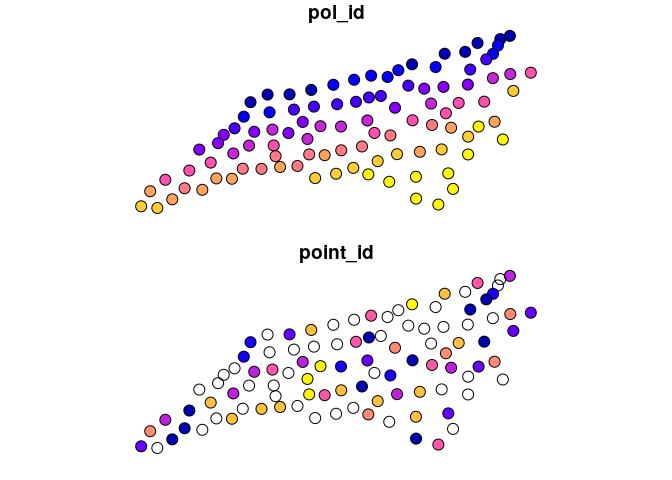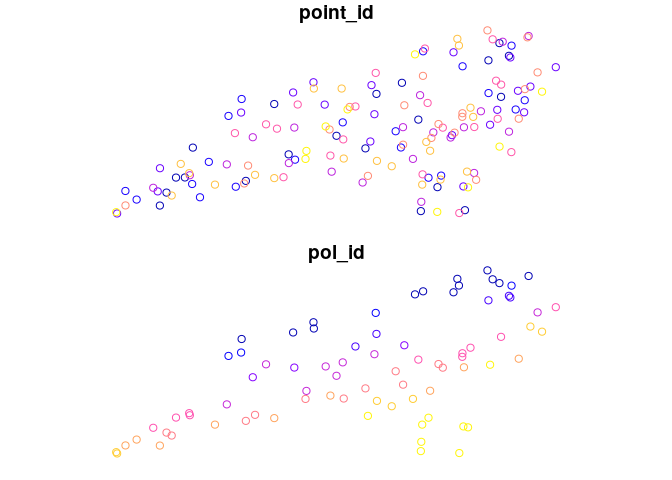Here is an example, with 100 polygons and 150 points, using similar syntax of st_join. I'm never getting more than one match when using k=1 (there can be zero matches when the nearest feature is further than maxdist).
If you can please post a reproducible example where you are getting more than one match will be happy to look into it.
library(sf)
## Linking to GEOS 3.7.1, GDAL 2.4.0, PROJ 5.2.0
library(nngeo)
# Sample data
nc = st_read(system.file("shape/nc.shp", package="sf"))
## Reading layer `nc' from data source `/home/michael/R/x86_64-pc-linux-gnu-library/3.6/sf/shape/nc.shp' using driver `ESRI Shapefile'
## Simple feature collection with 100 features and 14 fields
## geometry type: MULTIPOLYGON
## dimension: XY
## bbox: xmin: -84.32385 ymin: 33.88199 xmax: -75.45698 ymax: 36.58965
## epsg (SRID): 4267
## proj4string: +proj=longlat +datum=NAD27 +no_defs
nc = st_transform(nc, 2163)
pol = st_centroid(nc)
## Warning in st_centroid.sf(nc): st_centroid assumes attributes are constant
## over geometries of x
pol = st_buffer(pol, 10000)
pol$pol_id = 1:nrow(pol)
pol = pol[, "pol_id"]
set.seed(2)
pnt = st_sample(nc, 150)
pnt = st_as_sf(pnt)
pnt$point_id = 1:nrow(pnt)
# Plot sample data
plot(st_geometry(pol))
plot(pnt, add = TRUE, col = "red")

# Find nearest point per polygon
matched = st_join(pol, pnt, join = nngeo::st_nn, maxdist = 5000, k = 1, progress = FALSE)
matched
## Simple feature collection with 100 features and 2 fields
## geometry type: POLYGON
## dimension: XY
## bbox: xmin: 1434397 ymin: -972247.3 xmax: 2163573 ymax: -638980.7
## epsg (SRID): 2163
## proj4string: +proj=laea +lat_0=45 +lon_0=-100 +x_0=0 +y_0=0 +a=6370997 +b=6370997 +units=m +no_defs
## First 10 features:
## pol_id point_id geometry
## 1 1 36 POLYGON ((1653386 -769725.7...
## 2 2 NA POLYGON ((1684474 -755795.8...
## 3 3 43 POLYGON ((1724447 -755458.3...
## 4 4 76 POLYGON ((2125485 -648980.7...
## 5 5 139 POLYGON ((2006808 -681505.5...
## 6 6 NA POLYGON ((2044114 -678049, ...
## 7 7 NA POLYGON ((2108020 -654859.7...
## 8 8 90 POLYGON ((2066626 -661943.5...
## 9 9 141 POLYGON ((1947392 -700792, ...
## 10 10 134 POLYGON ((1763898 -747402.5...
plot(matched)

# Find nearest polygon per point
matched = st_join(pnt, pol, join = nngeo::st_nn, maxdist = 5000, k = 1, progress = FALSE)
matched
## Simple feature collection with 150 features and 2 fields
## geometry type: POINT
## dimension: XY
## bbox: xmin: 1439778 ymin: -951909.3 xmax: 2156285 ymax: -653444.2
## epsg (SRID): 2163
## proj4string: +proj=laea +lat_0=45 +lon_0=-100 +x_0=0 +y_0=0 +a=6370997 +b=6370997 +units=m +no_defs
## First 10 features:
## point_id pol_id x
## 1 1 NA POINT (1564713 -844541.5)
## 2 2 NA POINT (1963419 -909022.2)
## 3 3 29 POINT (1863993 -756996.4)
## 4 4 NA POINT (1551746 -893225.5)
## 5 5 66 POINT (1521780 -917867.4)
## 6 6 8 POINT (2064407 -674241.4)
## 7 7 67 POINT (1846009 -845801.1)
## 8 8 NA POINT (2008213 -946539.7)
## 9 9 21 POINT (2079893 -694914.8)
## 10 10 54 POINT (1932235 -798927.7)
plot(matched)






matchingRpackage using a negative distance matrix as the utility and am getting interesting and feasible results - any use?